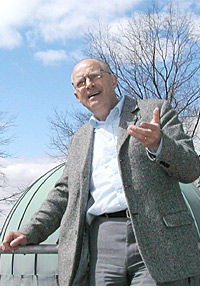PrincetonUniversity
Paczynski 'OGLEs' the sky for answers to cosmic questions
by Steven Schultz
To most of us, the night sky is a steady backdrop. The only change we
know is the seasonal rotation of the constellations. For Princeton astrophysicist
Bohdan Paczynski, however, the sky teems with fast-changing events.
|
|
||
|
|
|
Paczynski, the Lyman Spitzer Professor of Theoretical Astrophysics, has found that subtle, but often highly regular, variations in the light of stars can provide insights into longstanding problems in astronomy, from finding planets around other stars to estimating the age of the universe.
For the past 10 years, Paczynski and a small group of collaborators here and in his native Poland have pioneered a method of surveying large patches of the sky many times a night in search of anything that changes.
As a technical feat alone, the project is remarkable. Last July and August, the group tracked 5 million stars over a six-week period, making 800 observations of each star. During the peak viewing periods, the astronomers recorded data on all 5 million stars every 12 minutes.
Their ability to perform such a rapid search grows out of years of refinements the researchers have made to their equipment, which includes their own telescope at the Las Campanas Observatory in Chile. A large digital camera records detailed information over a wide area and feeds it to software that automatically sorts out interesting events worthy of further study.
Earlier this year, the group, including Princeton graduate student Przemyslaw Wozniak and the lead member of the team in Poland, Andrzej Udalski of Warsaw University, published a free Internet database of 250,000 variable stars from a survey conducted from 1997 to 1999. The project, known by the acronym OGLE, has become an important source of data to scientists working in many aspects of astronomy.
Read the full story in the Weekly Bulletin.

Astrophysics professor Bohdan Paczynski, pictured here near the observatory
on the roof of Peyton Hall, is part of a group that has pioneered a method
of surveying large patches of sky.
photo: Evelyn Tu
University home | Previous caption pages | Communications Office | Web page feedback
© 2002 The Trustees of Princeton University